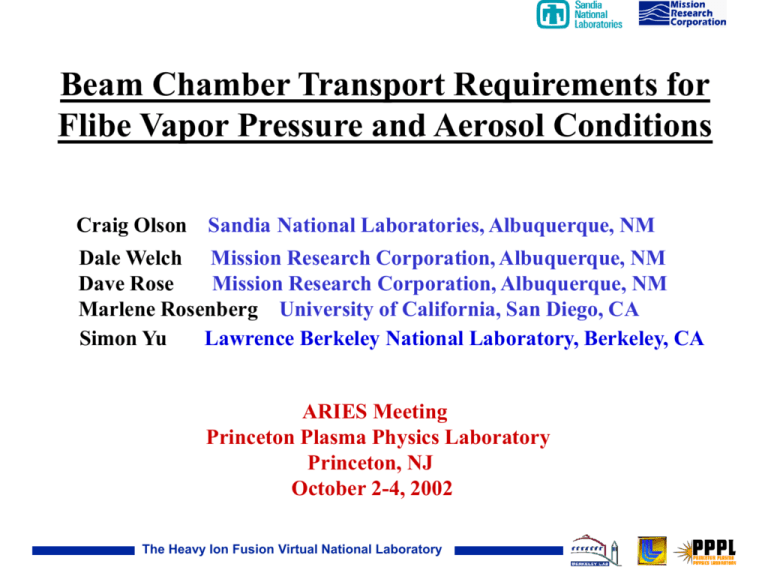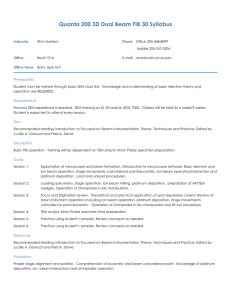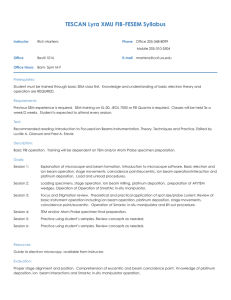Power Point - Fusion Energy Research Program
advertisement

Beam Chamber Transport Requirements for Flibe Vapor Pressure and Aerosol Conditions Craig Olson Sandia National Laboratories, Albuquerque, NM Dale Welch Mission Research Corporation, Albuquerque, NM Dave Rose Mission Research Corporation, Albuquerque, NM Marlene Rosenberg University of California, San Diego, CA Simon Yu Lawrence Berkeley National Laboratory, Berkeley, CA ARIES Meeting Princeton Plasma Physics Laboratory Princeton, NJ October 2-4, 2002 The Heavy Ion Fusion Virtual National Laboratory Outline Motivation transport modes effects of increasing line charge density Aerosol effects on ballistic transport E/x scattering stripping charged droplet effects micro-breakdown plasma-like effects Net effect of aerosols integrated line density effects on ballistic, channel, self-pinched transport The Heavy Ion Fusion Virtual National Laboratory Neutralized Ballistic (mainline) The Heavy Ion Fusion Virtual National Laboratory Pinch modes (backup) Aerosols may affect neutralized ballistic transport with thick liquid walls (the mainline approach for HIF) Chamber Transport Accelerator exit Final Focus Drift compression Multiple beams converge onto one side of target, and Flibe jets for thick liquid wall chamber (Per Peterson HIF2002 Invited Talk) The Heavy Ion Fusion Virtual National Laboratory ARIES-IFE Study of HIF - Aerosol Effects () Transport Mode Chamber Concept Ballistic Transport chamber holes 5 cm radius most studied Vacuum-ballistic Neutralized-ballistic vacuum plasma generators ARIES-IFE (2002) Dry-wall 6 meters to wall Not considered now: Possible option: but tighter constraints Requires 500 or on vacuum and more beams beam emittance HIBALL (1981) Wetted-wall 4-5 meters to wall Thick-liquid wall 3 meters to wall Not considered: Needs 0.1 mTorr leads to Not considered: Needs 0.1 mTorr leads to OSIRIS-HIB (1992) ARIES-IFE (2002) Possible option: but tighter constraints on vacuum and beam emittance HYLIFE II (1992-now) ARIES-IFE (2002) Main-line approach: uses pre-formed plasma and 1 mTorr for 3 meters 50-200 beams The Heavy Ion Fusion Virtual National Laboratory Pinch Transport chamber holes 0.5 cm radius higher risk, higher payoff Preformed channel ("assisted pinch") laser + z-discharge ARIES-IFE (2001) Self-pinched only gas ARIES-IFE (2001) Option: uses 1-10 Torr Option: uses 1-100 mTorr 2-100 beams 2 beams ARIES-IFE (2001) PROMETHEUS-H (1992) ARIES-IFE (2001) Option: uses 1-10 Torr Option: uses 1-100 mTorr 2 beams ARIES-IFE (2002) 2-100 beams ARIES-IFE (2002) Option: uses 1-10 Torr Option: uses 1-100 mTorr 2 beams 2-100 beams A Series of Scaled Experiments at LBNL will address science issues of HIF Concept: keep perveance K at driver-scale, and progressively increase FFSE (Final Focus Scaled Experiment) Completed 160 keV Cs+, 95 - 400 A, electron neutralization = 2-8 x 10-4 C/m K = 1-4 x 10-5, NTX (Neutralized Transport Experiment) neutralized ballistic transport up 400 keV K+, 75 mA, K 10-3, HCX (High Current Experiment) 1.8 MeV K+, 0.8 A 10-20 MeV K+, 10 A (final) 0.05 C/m quadrupole transport in accelerator K 10-3, IBX (Integrated Beam Experiment) Proposed first integrated system/bunching final 1-2 C/m integrated system/heat matter The Heavy Ion Fusion Virtual National Laboratory 200 MeV K+, 500A (final) Underway 0.2 C/m K 10-3, IRE (Integrated Research Experiment) Being set K 7.5 x 10-4, 17 C/m Future Several quantities scale with the line charge density Beam potential: 0 = qIp/(c) = Electric field at beam edge: E0 = 20/rb = 2/rb Current (electric): Ie = c Magnetic field at beam edge: B0 = 2Ie/(crb) = 2/rb Time scale for electron motion: = 2R/(ec) where (1/2)mee2c2 = e0, so -1/2 Beam density: nb = /(rb2qe) Beam plasma frequency: bi = [4nbqe2/(AMp)]1/2 1/2 Beam cyclotron frequency: ci = qB/(AMpc) -4 Example: FFSE, 8x10 C/m, e0 8 eV, E0 16 V/cm (for rb = 1 cm) Driver, 80 C/m, e0 0.8 MeV, E0 1.6 MV/cm (for rb = 1 Electron motion, non-local ionization, beam pinching, bi, ci, etc., increase with cm) Need to study possible aerosol effects as increases toward driver scale The Heavy Ion Fusion Virtual National Laboratory Aerosol effects for neutralized ballistic transport • • E/ x Scattering • Stripping • Charged droplets charging processes role of ion beam in charging max f that droplet can attain simple deflection due to E Micro-breakdown fine mist, beam E leads to breakdown beam induced ionization of aerosol • • find aerosol limit for 10% energy loss assume emittance dominated spot find limit for 10% increase in spot area (5% in radius) find limit for onset Plasma-like effects of “charged aerosol” Debye -like effects dusty plasma effects plasma waves, etc. The Heavy Ion Fusion Virtual National Laboratory Fill fraction for droplets Assume droplets are liquid spheres of radius r (all one size) Assume packed like cubes, so (2r)3 = (1/naerosol)f where f = fill fraction naerosol = aerosol density So naerosolr3 = (1/8) f naerosol(cm-3) 1012 109 106 103 1 f=1 0.5 5 50 500 5000 r(microns) for f=10-3 f=10-6 0.05 0.5 5 50 500 The Heavy Ion Fusion Virtual National Laboratory 0.005 0.05 0.5 5 50 : f=10-9 0.0005 0.005 0.05 0.5 5 Limits to naerosolr3 in terms of equivalent density For effects that depend only on integrated line density, (e.g., E/x, scattering, stripping, …), use equivalent density: naerosol N = nequivalent where N = #atoms/droplet = (4/3)r3nliquid Therefore, naerosol r3 = [3/(4)] nequivalent / nliquid Now, calculate nequivalant for each effect The Heavy Ion Fusion Virtual National Laboratory E/x limit Classical stopping (non-rel.): -E/x = [(4nZq2e4)/(mev2)] ln [mev3/(Ze2)] incident beam ion: +qe, v background medium: n(atom density), Z electrons/atom Limit when [-E/x] L = E0 where = fractional energy loss allowed Therefore: nequivalent = mev2E0/(4Zq2e4L ln[ ]) For: 4 GeV Pb, L = 500 cm, = 0.1, Z = 3, ln[ ] = 5; nequivalent = 4.2 x 1021 cm-3 4.2 x 1019 cm-3 6.2 x 1017 cm-3 for q = +1 for q = +10 for q = +82 The Heavy Ion Fusion Virtual National Laboratory Scattering limit Multiple small-angle scattering: Qrms = [ Q2 ]1/2 where Q2 = 2 nL[2qZe2 /(Mv2 ]2 ln [bmax /bmin ] incident beam ion: +qe, M, v background medium: n(atom density), Z charge on nucleus Limit when Qrms = [(1/2) rs ]/[(1/2)L] where rx = spot radius Therefore: nequivalent = [( rs Mv2 )/(L2qZe2 )]2 (2 L ln[ ])-1 For: 4 GeV Pb, L = 500 cm, = 0.1, Z = 3, ln [ ] = 5, rs=0.2 cm ; nequivalent = 1.06 x 1018 cm-3 1.06 x 1016 cm-3 1.58 x 1014 cm-3 for q = +1 for q = +10 for q = +82 The Heavy Ion Fusion Virtual National Laboratory Stripping limit Use a pressure of 1 mTorr to represent onset of damaging stripping effects (based on LSP simulations of Welch and Rose) Then: nequivalent = 3.6 x 1013 cm-3 The Heavy Ion Fusion Virtual National Laboratory Charges on aerosol droplets (“initial conditions”) Example: H.E. Hesketh, Fine Particles in Gaseous Media (Lewis Pub., 1986) p.10, p.74. “As aerosols, fine particles can have no charge, a positive charge, or a negative charge” “Most particles larger than 1 m in diameter have charge +1 as a result of diffusion charging” Maximum possible charge (limited by air breakdown) is about +5 for a 0.1 m particle ( i.e., Q/M 10-7 e/Mp ) Example: E.C. Whipple, “Potentials of Surfaces in Space,” Rep. Prog. Phys. 44, 1197-1250 (1981). “Potentials of some tens of kV occur on objects in the solar system” “Lack of hard data on charging of natural objects” Example: V.W. Chow, D.A. Mendis, M. Rosenberg, “Role of Grain Size and Particle Velocity Distribution in Secondary Electron Emission in Space Plasmas,” J.G.R. 98, 19,065-19076 (1993). “By virtue of being generally immersed in a plasma environment, cosmic dust is necessarily charged” Charge may be + or “We find that for thermal energies that are expected in several cosmic regions, grains of Net charge to mass ratio is very different small sizes can have opposite charge, the smaller ones being positive while the larger ones are Net potential is very small negative” The Heavy Ion Fusion Virtual National Laboratory HIF beam injection through charged aerosol droplet LSP simulation results (see following talk by Rose et al.) HIF beam D droplet Net ef kTe 10 eV aerosol droplet may be initially charged, radius used is 1 m ion beam ionizes droplet and quickly forms plasma ( 1016/cm3, 10 eV) plasma shields charged droplet and limits net potential to ef kTe 10 eV Debye sheath: D ve/pe 0.2 m E f/D (10 V)/(0.2 m) 5x105 V/cm, but only over 0.2 m maximum deflection of ion in sheath is negligible compared to rs/L D rdroplet therefore, HIF beam deflection effects by “charged droplet deflection” are negligible Droplet causes usual losses by E/x, scattering, and stripping Integrated line density of aerosol droplets determines net effects The Heavy Ion Fusion Virtual National Laboratory Possibility of micro-breakdown of fine aerosol mist droplets inside the HIF beam quickly form plasmas droplets outside the HIF beam could be subject to net beam fields beam must be well-neutralized to hit target (fe 0.98), so net potential and Er of beam must be (0.02)(bare beam values) net value for an HIF driver beam would be ef 16 keV net minimum potential is given by (1/2)meVi2 10 keV are these potential large enough to cause mist breakdown to nearby surfaces? if this could occur, it would try to draw in electrons radially, but Effects appear to be would negligible not reduce the potential substantially only potential damaging effect might be if nearby boundary is The Heavy Ion Fusion Virtual National Laboratory not Plasma-like effects of charged aerosol particles behaves as a separate plasma species charge/mass ratio is very low, so plasma frequency is very low Debye shielding could occur (e.g., outside beam envelope) but with little effect on the beam plasma waves and instabilities could occur, but the time scale would be very long compared to the beam pulse length Example: M. Rosenberg, “Ion-Dust Streaming Instability Plasma-like effects of aerosols appear to be negligible for in HIF Processing Plasmas,” J. Vac. Soc. Technol. A 14, 631 The Heavy Ion Fusion Virtual National Laboratory (1996); Examples of naerosolr3 for ballistic transport Recall: naerosol r3 = [3/(4 )] nequivalent / nliquid Use: nliquid = 1022 cm-3 Then: naerosol r3 = 1.0 x 10-3 for E/ x limit for q = +10 naerosol r3 = 0.25 x 10-6 for scattering limit for q = +10 naerosol r3 = 0.86 x 10-9 for stripping aerosol charge effects, micro-breakdown effects, plasma effects negligible Worst case is for stripping Example (use naerosol r3 = 1 x 10-9 ): naerosol (cm-3 ) r (micron) 1012 109 106 103 1 The Heavy Ion Fusion Virtual National Laboratory 0.001 0.01 0.1 1 10 Aerosol effects on neutralized ballistic transport naerosol raerosol3 = 1x10-9 Stripping is dominant limit Integrated line density equivalent to 1 mTorr The Heavy Ion Fusion Virtual National Laboratory Aerosol effects on channel transport Start with 1-10 Torr, and fully stripped beam E/x limit is nequivalent = 6.2 x 1017 cm-3 scattering limit (for 0.1) is nequivalent = 3.95 x 1016 cm-3 naerosol raerosol3 1 x 10-6 Scattering is dominant limit Integrated line density equivalent to 1 Torr The Heavy Ion Fusion Virtual National Laboratory Aerosol effects on self-pinched transport Start with 1-100 mTorr, and fully stripped beam E/x limit is nequivalent = 6.2 x 1017 cm-3 scattering limit (for 0.1) is nequivalent = 3.95 x 1016 cm-3 BUT, self-pinched process will require nequivalent 3.6 x 1015 cm-3 naerosol raerosol3 1 x 10-7 Self-pinched process is dominant limit Integrated line density equivalent to 100 mTorr The Heavy Ion Fusion Virtual National Laboratory ARIES-IFE Study of HIF - Aerosol Effects Summary Ballistic Transport Transport Mode chamber holes 5 cm radius most studied Chamber Concept Neutralized-ballistic vacuum plasma generators Preformed channel ("assisted pinch") laser + z-discharge N/A N/A N/A nr3 1x10-9 Wetted-wall 4-5 meters to wall nr3 1x10-6 Self-pinched only gas N/A nr3 1 x 10-7 N/A integrated line n 1 mTorr nr3 1x10-9 Thick-liquid wall 3 meters to wall chamber holes 0.5 cm radius higher risk, higher payoff Vacuum-ballistic Dry-wall 6 meters to wall Pinch Transport integrated line n 1 Torr nr3 1 x 10-6 Integrated line n 100 mTorr nr3 1 x 10-7 N/A integrated line n 1 mTorr The Heavy Ion Fusion Virtual National Laboratory Integrated line n 1 Torr Integrated line n 100 mTorr Conclusions for Aerosol Effects on HIF Transport neutralized ballistic: most stringent stripping sets limit integrated line density equivalent to 1 mTorr channel transport: most forgiving scattering sets limit integrated line density equivalent to 1 Torr self-pinched transport: in between self-pinch sets limit integrated line density equivalent to 100 The Heavy Ion Fusion Virtual National Laboratory mTorr What needs to be done 1. What needs to be done to complete this work? Write up Determine if expected aerosol distribution is good enough Fix it if necessary 2. What can be done by the ARIES team (or you) to address these issues? Self-pinched transport theory (analytic envelope, LSP) Determine expected aerosol distribution 3. What modeling/experimental work can be done to resolve these issues? Ballistic transport experiments: NTX + metal arc source to make Al micro-particles IBX + aerosols Pinched mode transport experiments: Need high current! Not planned until IRE BUT, maybe high-Z ion diode or Mercury at NRL The Heavy Ion Fusion Virtual National Laboratory







